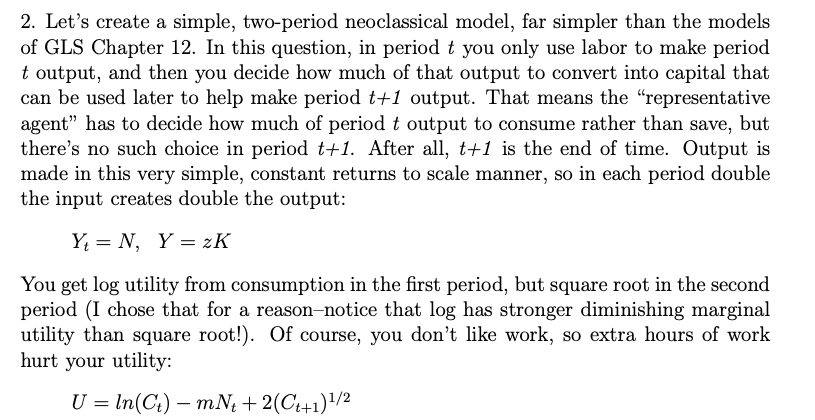2. Let's create a simple, two-period neoclassical model, far simpler than the models of GLS Chapter 12. In this question, in period t you only use labor to make period t output, and then you decide how much of that output to convert into capital that can be used later to help make period t+1 output. That means the "representative agent" has to decide how much of period t output to consume rather than save, but there's no such choice in period t+1. After all, t+1 is the end of time. Output is made in this very simple, constant returns to scale manner, so in each period double the input creates double the output: YN, YzK You get log utility from consumption in the first period, but square root in the second period (I chose that for a reason-notice that log has stronger diminishing marginal utility than square root!). Of course, you don't like work, so extra hours of work hurt your utility: U = ln(Ct) mNt + 2(C++1) 1/2 -
2. Let's create a simple, two-period neoclassical model, far simpler than the models of GLS Chapter 12. In this question, in period t you only use labor to make period t output, and then you decide how much of that output to convert into capital that can be used later to help make period t+1 output. That means the "representative agent" has to decide how much of period t output to consume rather than save, but there's no such choice in period t+1. After all, t+1 is the end of time. Output is made in this very simple, constant returns to scale manner, so in each period double the input creates double the output: YN, YzK You get log utility from consumption in the first period, but square root in the second period (I chose that for a reason-notice that log has stronger diminishing marginal utility than square root!). Of course, you don't like work, so extra hours of work hurt your utility: U = ln(Ct) mNt + 2(C++1) 1/2 -
Principles of Economics 2e
2nd Edition
ISBN:9781947172364
Author:Steven A. Greenlaw; David Shapiro
Publisher:Steven A. Greenlaw; David Shapiro
Chapter24: The Aggregate Demand/aggregate Supply Model
Section: Chapter Questions
Problem 14SCQ: If the economy is operating in the neoclassical zone of the SRAS curve and aggregate demand falls,...
Related questions
Question

Transcribed Image Text:2. Let's create a simple, two-period neoclassical model, far simpler than the models
of GLS Chapter 12. In this question, in period t you only use labor to make period
t output, and then you decide how much of that output to convert into capital that
can be used later to help make period t+1 output. That means the "representative
agent" has to decide how much of period t output to consume rather than save, but
there's no such choice in period t+1. After all, t+1 is the end of time. Output is
made in this very simple, constant returns to scale manner, so in each period double
the input creates double the output:
YN, YzK
You get log utility from consumption in the first period, but square root in the second
period (I chose that for a reason-notice that log has stronger diminishing marginal
utility than square root!). Of course, you don't like work, so extra hours of work
hurt your utility:
U = ln(Ct) mNt + 2(C++1) 1/2
-
Expert Solution
This question has been solved!
Explore an expertly crafted, step-by-step solution for a thorough understanding of key concepts.
This is a popular solution!
Trending now
This is a popular solution!
Step by step
Solved in 2 steps

Recommended textbooks for you

Principles of Economics 2e
Economics
ISBN:
9781947172364
Author:
Steven A. Greenlaw; David Shapiro
Publisher:
OpenStax

Principles of Economics 2e
Economics
ISBN:
9781947172364
Author:
Steven A. Greenlaw; David Shapiro
Publisher:
OpenStax